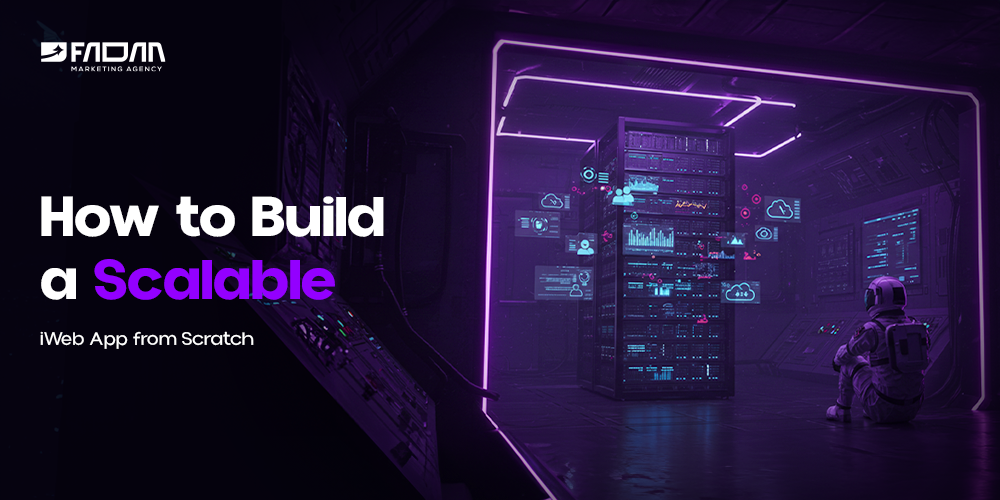In today’s fast-paced digital world, launching a web application is just the beginning. The real challenge lies in building one that can scale one that grows with your users and handles increasing traffic, features, and data without compromising performance. Whether you're an entrepreneur, a product manager, or a developer, understanding how to build a scalable web app from scratch is essential.
In this guide, we’ll walk through the fundamental steps to building a robust, high-performing, and scalable web app. We'll also highlight how Fadaa Digital Agency helps businesses across the region create applications that are not only scalable but future-ready.
A scalable web app is one that can handle increasing loads of users, data, and activity without sacrificing speed or functionality. Scalability ensures:
Smooth performance as user base grows
Lower maintenance and infrastructure costs
Stability and reliability during traffic spikes
Easy implementation of new features
Whether you’re building the next e-commerce platform, a SaaS product, or a community-driven app, scalability is the key to long-term success.
Scalability starts with choosing the right architecture. You need to design with growth in mind.
Microservices: Break your application into smaller, independent services.
Serverless: Use cloud services like AWS Lambda to handle dynamic scaling automatically.
Monolith with Modularity: If starting small, structure your code in a modular way to easily refactor later.
The earlier you plan your architecture for scalability, the easier it will be to expand later.
Your tech stack will greatly influence how scalable your app becomes. Here’s a sample full-stack setup optimized for growth:
Frontend: React.js / Next.js (component-based and fast)
Backend: Node.js / Django / Ruby on Rails
Database: PostgreSQL (for structured data) + Redis (for caching)
Infrastructure: AWS, GCP, or Azure
DevOps Tools: Docker, Kubernetes, CI/CD pipelines
Using popular, well-supported technologies ensures better documentation, easier hiring, and community-driven scalability tools.
To build a scalable web app, you must optimize performance from day one:
Use Asynchronous Processing: Offload tasks like email sending and file uploads to background queues (e.g., Celery, RabbitMQ).
Implement Caching: Use Redis or Memcached to cache frequent queries.
Lazy Loading: Only load what the user needs at that moment.
Content Delivery Network (CDN): Serve assets from global nodes.
Think like a user—no one wants to wait 5 seconds for a dashboard to load!
Relational databases (MySQL, PostgreSQL) are great—but scaling them requires planning:
Use read replicas for high-volume reads.
Use database sharding for horizontal scaling.
Use NoSQL options like MongoDB for flexible schemas.
Make sure your schema can evolve without breaking old data—versioning and migrations should be part of your dev process.
More users = more security risk. As you scale, your app becomes a more attractive target.
Use secure authentication frameworks (OAuth 2.0, JWT)
Apply role-based access control (RBAC)
Enable rate limiting and bot protection
Regularly run vulnerability scans
A secure foundation saves you from expensive problems in the future.
Modern web apps thrive on automation:
CI/CD Pipelines: Use tools like GitHub Actions or Jenkins to automate testing and deployment.
Auto-Scaling Infrastructure: Set up your servers to scale based on traffic.
Monitoring Tools: Use tools like Datadog, New Relic, or Prometheus to track app health in real-time.
Don’t rely on manual fixes—build a system that heals itself.
A truly scalable app doesn’t just handle thousands of users—it works for them wherever they are.
Use internationalized domains and multi-language support.
Set up regional CDNs to reduce latency.
Ensure mobile-friendliness and responsive design.
Your app should perform just as well in Riyadh as it does in New York.
At Fadaa Digital Agency, we help companies turn ideas into scalable, secure, and successful web apps.
Whether you're a startup founder or an enterprise looking to modernize your platform, we bring:
Custom Scalable Architecture Design
Expert Frontend and Backend Development
Performance Optimization and Caching Strategies
Cloud Deployment with AWS/GCP/Azure
Ongoing Monitoring and Scaling Support
We don’t just build apps—we build digital products designed to grow with your business. Let Fadaa be your strategic partner in your next web development journey.
Learning how to build a scalable web app from scratch takes planning, the right tools, and an eye on the future. From architecture and databases to performance and automation, every decision you make will impact how your app grows.
Don't let your app fall apart under success—build with scalability in mind, and you’ll be ready for whatever comes next.
 July 17, 2025 - BY Admin
July 17, 2025 - BY Admin